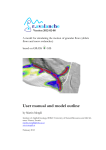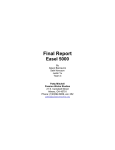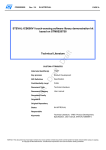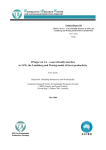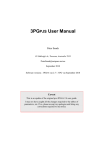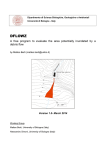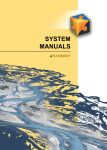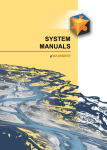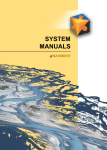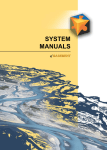Download r.debrisflow User manual and model outline
Transcript
Version 2012-02-08 A model framework for simulating mobilization and movement of debris flows based on GRASS GIS User manual and model outline by Martin Mergili Institute of Applied Geology, BOKU University of Natural Resources and Life Sciences Vienna, Austria [email protected] www.mergili.at February 2012 2 r.debrisflow r.debrisflow is a GIS-supported model framework for simulating the potential spatial patterns of debris flow initiation, movement, and deposition. It is physicallybased in general, but includes some empiricalstatistical components. r.debrisflow is designed as a raster module for the software GRASS. The scientific concepts behind r.debrisflow are summarized in Chapter 1 (Model outline). In contrast to most of the other GRASS raster modules, management of the data and the parameters (input and output) is not done by adding parameters to the r.debrisflow command, but by an additional shell script (r.debrisflow.sh) with various functionalities, including derivation of secondary input parameters from primary ones. This is required due to the complexity of the model framework. Instructions how to operate r.debrisflow are given in Chapter 2 (User’s manual). The model shows a large potential for refinements. Chapter 3 (Prospected improvements) will give a short overviev of ongoing and prospected further development of r.debrisflow, regarding the scientific concepts as well as its mode of operation. Every user is encouraged to report encountered bugs or errors to [email protected]. Furthermore, the developer would be grateful for receiving comments regarding • experiences with the program, shortcomings, recommendations for improvements (scientific concepts, ease of use); • parameters chosen for certain study areas; • interest in cooperation in application and further development. The model, as applicable with GRASS, is running under the GNU General Public License (www.gnu.org). r.debrisflow has been created with the purpose to be useful for modelling of debris flows. It has been developed with care, and much emphasis has been put on ensuring its scientific value. Nevertheless, every user has to be aware that it is only a computer program created by a human being, which may contain technical and topical errors and shortcomings. No responsibility can be taken by the developer for any types of deficiencies in the program or in the present document, or for the consequences of such deficiencies. ___________________________________________________________________________ 1 Model outline 3 1.8 References 9 1.1 General aspects 3 2 User’s manual 11 1.2 Hydraulic model components 4 1.2.1 Precipitation and snow melt 4 1.2.2 Interception 4 1.2.3 Evapotranspiration 5 1.2.4 Infiltration 5 1.2.5 Surface runoff 6 2.1 System requirements 11 1.3 Sediment transport model 6 1.3.1 Basic assumptions 6 1.3.2 Detachment and sediment concentration 7 1.4 Slope stability model 7 1.5 Debris flow runout 8 1.5.1 Initiation 8 1.5.2 Routing procedure 8 1.5.3 Runout distance and deposition 9 2.2 Test dataset 11 2.3 File management 11 2.4 Installation 12 2.5 Data management 12 2.5.1 Parameter and data input 12 2.5.2 Preparation of parameters 14 2.5.3 Execution of simulations 15 2.5.4 Post-processing of model output 15 2.5.5 Display of results 16 2.5.6 Removal of result files 17 2.5.7 Cleaning of file system 17 2.5.8 Exit 17 1.6 Model validation 9 3 Prospected improvements 18 1.7 Acknowledgements 9 3.1 Scientific concepts 18 3.2 Ease of use 18 Model outline 3 1 Model outline 1.1 General aspects The ideas for most of the model components were taken over from existing models, partly in a modified form. The model framework was named r.debrisflow (the r indicates that it is a GRASS raster module). It was kept relatively simple in its first version presented here, but was also designed in a way for allowing to be extended with more sophisticated modules in the future (compare Chapter 3). r.debrisflow was implemented using a 2.5D raster data model (the vertical dimension plays an important role, but is only quantified by attributes). It combines physically-based, deterministic modules and modules based on empirical relationships. r.debrisflow couples a hydraulic model, a slope stability model, a sediment transport model, and a debris flow runout model: • The deterministic hydraulic model distributes the water from precipitation or snow melt among vegetation (interception), soil (infiltration), and surface (runoff). It then approximates the soil water status and the runoff variables; • the deterministic slope stability model computes the factor of safety for each cell, based on an infinite slope stability model, and identifies potential starting areas of debris flows; • the sediment transport model (based on an empirical approach) provides an estimate for erosion and deposition by surface runoff, allowing to assess the tendency of bedload-rich runoff to develop into a debris flow; • 3: geotechnical mode B: the runoff and sediment transport models are excluded – like (2), but excluding the influence of runoff on infiltration: for conditions where it is known that no surface runoff develops; • 4: hydraulic mode: the slope stability model is excluded and only debris flows developing from sediment-laden runoff are modelled – for conditions where it is known that slope failures play no role for the mobilization of debris flows; • 5: fully saturated mode: it is assumed that the entire soil in the study area is saturated. With this precondition, the slope stability model and the runout model are computed; • 6: runout only mode: only the runout model is computed with defined areas of debris flow initiation – for testing the plausibility of the runout model for events of known patterns of debris flow initiation and deposition. The general model layout is illustrated in Figure 1. r.debrisflow considers the slope or catchment under investigation as six-layered system characterized by the following variables: • the overlying atmosphere is described by air temperature T (degree Celsius) and precipitation P (m); • snow cover is defined as snow depth ds (m); • land cover is defined by a raster layer representing nominal land cover classes. Minimum and maximum values of interception capacity ICP (m), root cohesion cr (N m-2), and rooting depth dr (m) have to be assigned to each class. A hydrological surface class and the width of the flow channels at a sub-cell scale are defined for each cell as well as the vegetation surcharge of Manning’s n nadd; • the surface water table is characterized by depth R (m) and flow velocity vflow (m s-1); • soil, here rather understood as sediment cover than as mixture of residuals from weathering and decomposed organic matter, is basically represented by a nominal soil class raster layer. A texture class, dry specific weight γ (N m-3), stone content s (m3 m-3), the hydraulic parameters θr, θs (m3 m-3), ψ (m) and K (m s-1), and the mechanical parameters soil cohesion cs (N m-2) and angle of internal friction φ are assigned to each soil class as well as minimum and maximum values for nbas. Soil depth d (m) is defined independ- • the debris flow runout model finally routes the debris flow downwards to the area of deposition, based on a two-parameter friction model. The modules are executed in a defined sequence for a user-defined number of time steps during and after a rainfall or snow melt event. Slope stability and runout are computed at the end of the last time step. Not all modules have to be executed – the following combinations (modes of simulation) are possible when running r.debrisflow: • 1: full mode: all modules are executed; • 2: geotechnical mode A: the sediment transport model is excluded, and only debris flows starting from slope failures are modelled – for conditions where it is known that debris flows only develop from slope failures; 4 r.debrisflow where ΣM is the daily snow melt (m d-1), and ddf is the degree-day factor (m °C-1 d-1). Tddf is the temperature in °C at a defined time of the day. In order to estimate snow melt of shorter time intervals, daily snow melt is distributed over the considered day, following a linear relationship with temperature: ently from the soil classes. All parameters are considered constant over the entire depth of the soil column; • bedrock is considered unconditionally stable. Its permeability for water is accounted for by the parameter pr, denoting the ratio of total effective rainfall and snow melt which percolates through the rock. pr is not defined as raster map, but globally for the considered study area. The following sections give a more detailed introduction to the physical and mathematical background of r.debrisflow. where T0 is the temperature during the cosidered time step, ΣT is the daily temperature sum, based on the length of one time step Δt (s). Only temperatures above Tcrit are included in the sum. 1.2.2 Interception 1.2 Hydraulic model components The interception capacity of the vegetation Ipot (m) is extracted from the land cover dataset. For each time step Δt (s) rainfall is retained as interception IΔt (m) until the interception capacity is reached (ΣIΔt = Ipot). The excess rainfall is added to the soil water table R (m) as effective rainfall Pr,eff (m). Water from snow melt is considered not interceptable by vegetation. This worst-case assumption was chosen due to the often unknown vertical distribution of Ipot. 1.2.1 Precipitation and snow melt Precipitation P (m) and air temperature T (°C) are read from the prepared datasets. Precipitation is considered as rainfall Pr if it exceeds a user-defined temperature threshold Tcrit, usually ranging between 0°C and 2°C. Snow melt M (m) is computed using a simple degree-day approach with air temperature as the only input: Eq. 1, ΣM = ddf ⋅ Tddf degree day factor DDF air temperature T precipitation P snow melt S interception capacity I interception I surface water depth R slope α Manning roughness n hydrological surface class flow directions slope α grain spec. weight γ g Green-Ampt model Manning's formula flow velocity v routing procedure flow discharge q sediment concentration C Rickenmann formula bedload discharge q b Corominas et al (2003) rules depth of detachment or deposition from surface runoff d w soil hydrological parameters s , θr, θs , ψ, K depth of wetting front d soil dry specific weight γ s soil cohesion c s infinite slope stability model input parameter working parameter effective rainfall P eff grain size distribution D30 , D50 , D90 Eq. 2, M = T0 ΣM ΣT root cohesion c r major output parameter model model in older versions work flow (all time steps) work flow (last time step) angle of internal friction φ factor of safety FOS rooting depth d r debris flow volume test of criteria runout distance potential starting areas of debris flows two-parameter friction model Rickenmann (1999) formula depth of detachment or deposition from debris flow Figure 1: General model layout of r.debrisflow. Designed by M. Mergili runout velocity loss of elevation Vandre (1985) rules slope α Model outline 5 depth. For each time step it is tested which case is applicable: • • • also the most simple equations for evapotranspiration require highly dynamic parameters that are usually not available at sufficient accuracy and resolution (humidity, irradiation, etc.); R f = R0 − fΔ t short (1 − s ) d = d 0 + Δt short f Δθ ⎞ ⎟⎟ ⎠ Eq. 4, where K (m s-1) is the hydraulic conductivity, R0 (m) is the depth of the surface water table before infiltration, ψ (m) is the matric suction at the wetting front, and d0 (m) is the depth of the wetting front before infiltration. Eq. 4 is derived from Darcy’s law (Xie et al. 2004; Chen & Young 2006). If no measurements of the soil hydraulic parameters are available, values for different texture classes can be obtained e.g. from Rawls et al. (1983) or from Carsel & Parrish (1988). Two possible cases have to be distinguished. f has to be corrected for volumetric stone content s, which does not affect the maximum possible depth of infiltration, but the volume that fits into the soil until this case 2: R0 ≤ f Δtshort (1-s) – inflow to the cell is equal or smaller than maximum possible infiltration capacity. In this case, the entire inflow infiltrates, d = d 0 + R0 [Δθ (1 − s )] Eq. 7, and no surface water table remains, meaning that no surface runoff will develop from the considered cell. Eq. 3, infiltration limited by infiltration capacity V inf < V surf old wetting front where Rprev is the depth of the surface water table at the end of the previous time step. The infiltration of water into the soil is a complex process influenced by an interplay of factors like the depth of the surface water table, the soil parameters, and the local topography. It was chosen to use the Green & Ampt (1911) approach, assuming a sharp wetting front as the interface between saturated soil above and soil at initial moisture content below (Figure 2). The hydraulic parameters governing infiltration are derived from the grain size class of the soil. Infiltration capacity f (m s1) can be stated as ⎛ R +ψ f = K ⎜⎜1 + 0 d0 ⎝ • potential depth of infiltration Δtshort (Peff ,t + M t ) Δt Eq. 6, where Δθ is the moisture deficit of the soil (difference between saturated water content θs and initial water content θi; all in m3 m-3); 1.2.4 Infiltration R0 = R prev + Eq. 5, Infiltration is limited by the infiltration capacity, and the depth of the new wetting front d (m) is computed as follows: the model is designed primarily for short and intense rainfall events, where evapotranspiration is rather negligible. Regarding snow melt, neglect of evapotranspiration may lead to more significant inaccuracies. Infiltration, runoff, and sediment transport have to be calculated at much shorter time steps Δtshort than the other processes, meaning that the entire sequence has to be repeated for various times within each basic time step Δt. Δtshort is determined according to Eq. 14. The water input from effective rainfall and the snow melt are added to the surface water table of the cell at the beginning of each short time step: case 1: R0 > f Δtshort (1-s) – inflow to the cell exceeds maximum possible infiltration and depth of surface water table after infiltration Rf (m) is expressed as V surf infiltration limited by surface water table V inf = V surf surface water table V surf V inf V inf ∆Θ (1-s ) ∆Θ (1-s ) already saturated soil Potential evapotranspiration Epot (m) is set to zero. This is a worst-case assumption again which was chosen for two reasons: new saturated soil 1.2.3 Evapotranspiration soil at initial moisture content Figure 2: Infiltration into the soil according to the Green & Ampt (1911) model, as applied for the present study. Vsurf = volume of surface water before infiltration, Vinf = infiltrated volume. Designed by M. Mergili. For case 1, s has no direct influence on d, for case 2, d increases with increasing s. The application of this method has to be considered as an approximation: • The Green-Ampt approach, in its strict sense, was developed for horizontal surfaces, but is also applied for slopes. Chen & Young (2006) showed that on slopes until 45°, the effect of slope angle is small, compared to other sources of inaccuracy; • stone content is not accounted for in the original model. Therefore it was decided to disregard its influence on infiltration capacity, but its role as 6 Model outline limiting the infiltrable volume was taken into account. More research would be necessary in order to clarify the inaccuracies connected to this simplification. Slope-parallel seepage is neglected in the model. The infiltration is computed separately for soil below flow channels and soil in between flow channels. In between flow channels, ΣIF and OF are zero (compare Eq. 13 and 14). The integral form of the Green-Ampt approach (compare e.g. Xie et al. 2004) is not used as the model is run in short time steps with varying rainfall intensities. slopes, inaccuracies of the DEM or landforms on a sub-cell scale may exert a stronger effect on flow direction than on steep slopes. For both cases, inflow ΣIF (m) is computed with the Manning formula in the same way: vf low = 1 nman R f 3 (sin α )2 2 1 Eq. 8, where α is the local slope angle in degrees and nman is the surface roughness (determined by vegetation, soil texture, and obstacles), which is computed using nman = m(nbas + nsdd ) Eq. 9, where m is a factor accounting for meandering, nbas is the basic n value, and nadd is a surcharge for vegetation, obstacles, etc. m is automatically set to 1.0 since the model presented here is designed for steep terrain with poor meandering of the channels. The water discharge per unit width q (m2 s-1) is computed as follows: q = v flow R f = 5 1 1 R f 3 (sin α )2 n man Eq. 10. v flow Δtshort i =1 d h,i i=n 1 i =1 nman ,i =∑ 1 Δt short 3 R f ,i (sin α i )2 d h ,i 5 Eq. 12, where n is the number of contributing upslope cells, dh,i (m) is the horizontal distance between the centre of the cell i and the centre of the considered cell. Outflow OF (m) is computed in an analogous way: 1.2.5 Surface runoff After computing infiltration, the ponded water of the depth Rf is assumed to concentrate in the flow channels immediately and to run off superficially. Strictly spoken, Rf = Aflow/Pwet, where Aflow (m²) stands for the cross section of the flow, and Pwet (m) is the wetted perimeter, but in the model, Rf is approximated by flow depth. Runoff velocity vflow (m s-1) is computed using the Manning formula: i=n ΣIF = ∑ R f ,i OF = R f v flow Δt short Eq. 13, dh where dh (m) stands for the horizontal distance between the centre of the considered cell and the centre of the downslope cell. The length of one short time step Δtshort (s) is defined as Δtshort = a d cell vmax Eq. 14, where a is a factor ≤ 1 set to 0.5, dcell (m) is the cell size and vmax (m s-1) is the maximum runoff velocity over the entire area. Too short time steps would unnecessarily increase computing time. Δtshort is defined by the program automatically according to Eq. 14, using the maximum flow velocity of the previous time step over all cells. Δtshort is set to 20 s if dcell/vmax exceeds a threshold value. If no runoff occurs at all, Δtshort is set to 120 s. The depth of the water table R for each cell is computed as follows: R = R f + T + M + ΣIF − OF Eq. 15, where T is the effective rainfall, M is the snow melt, ΣIF stands for the total inflow from all the upslope cells directly draining into the considered cell, and OF stands for the outflow (all values in meters). Surface runoff is computed separately for each hydrological surface class HSC: 1.3 Sediment transport model • 1.3.1 Basic assumptions • HSC = 1 (defined channel): the water is routed through the channel, with only one possible downward direction from each cell; HSC = 2 (slope with numerous small channels or no channels at all): the water is routed downwards assuming the defined channel densities on a sub-cell scale and a random walk weighted for slope angle: w=α u1 Eq. 11, where w is the weight assigned to each potential flow direction and u1 is a user-defined exponent (values of 3 to 4 appear reasonable) – on gentle Surface runoff, independently of occurring as overland flow or channel flow, has a certain capacity to transport sediment. If the actual load is below transport capacity, soil from the bed is eroded, whilst sediment is deposited in the reverse case. The following assumptions are set in the model: • only bedload is considered as relevant regarding the magnitude of sediment transport and the evolution of debris flows. Suspended load is neglected; Model outline 7 • runoff is considered to follow hydraulic principles to a certain threshold of sediment concentration; at higher sediment concentrations it is considered as debris flow. • the bedload discharge immediately reaches an equilibrium (only if ST3 = ST4 = 1). 1.4 Slope stability model 1.3.2 Detachment and sediment concentration The hydraulic model components supply saturated depth d (m). It is assumed that The Rickenmann (1990) equation is used in the model for estimating sediment transport because it is best suited for relatively steep channels and high sediment concentrations. It only includes bedload. The original equations, mainly derived from laboratory tests, yielded very high values of detachment when applied to the study areas. Furthermore, the equation does not say anything about detachment rates. For these reasons, the dimensionless calibration parameters ST1, ST2, ST3, and ST4 had to be introduced: • qb = ST1 12.6 ⎛ D90 ⎞ ⎜ ⎟ (s − 1)1.6 ⎝ D30 ⎠ 0.2 (q − qcr )(sin α )2 Eq. 16, where qb (m2 s-1) is the volumetric bedload transport per unit width, s is the ratio between grain and fluid densities, D90 and D30 (m) are the grain sizes where 90% and 30% per weight, respectively, are finer, q (m2 s-1) is the fluid discharge per unit width, and α (degree) is the local slope angle. qcr (m2 s-1) is the threshold discharge for sediment transport: qcr = ST2 0.065(s − 1) 1.67 0.5 1.5 g D50 (sin α ) −1.12 Eq. 17, slope failures only occur at the depth d (the wetting front); • if total soil depth is known, slope failures are also allowed to occur at the soil-bedrock interface, but only if the entire soil is saturated (mathematically identical to slope failures at the wetting front). An infinite slope stability model (Figure 3) is used for the calculations. Therefore a wide ratio between slope length and depth of the failure plane is required in order to yield an acceptable approximation – a condition that is usually met for shallow, but not for deepseated failures. Furthermore, infinite slope stability models assume a translational failure mechanism, which usually only occurs in cohesionless soils. For cohesive soils, the model may still derive reasonable approximations of the factor of safety, but is – strictly spoken – not really applicable. γ ‘ = submerged unit weight γ w = unit weight of water G ‘ = weight of moist soil N = normal force T = shear force F s = seepage force T f = shear restistance force Eq. 18, d w = ST4 (l0 − qb v ) for l0 > qb v Eq. 19, l = l0 − d w = qb v Eq. 20, C = l (l + R ) Eq. 21, • R FOS = Tf / (T + F s ) d FOS > 1: cell is stable FOS < 1: cell is pot. unstable T the bedload moves at the same velocity as the water; Fs α N where l0 (m) is the depth of bedload at the start of the time step. Negative values of dw (Eq. 18) indicate detachment, positive values (Eq. 19) indicate deposition. Only saturated soil is allowed to be detached. All the sediment deposited is considered as saturated, and the depth of the wetting front below the flow channel(s) is corrected for detachment and deposition. Eq. 18 to 20, which are not part of the original Rickenmann model, are based on two rough generalizations: G‘ = γ ‘ ∆x d N = G ‘ cos α T = G ‘ sin α F s = ∆x d γ w sin α T f = N‘ tan φ + c ∆x / cos α where D50 (m) is the median grain size, and g (m s-2) is the gravitational acceleration. Erosion (detachment of soil) or deposition dw (m), depth of bedload l (m), and sediment concentration C (m3 m-3) can then be derived: d w = ST3 (l0 − qb v ) for l0 < qb v R = ponding depth (hydr. radius) d = depth of potential failure plane = depth of wetting front G‘ ∆x γ‘ γd Figure 3: Mechanisms for infiltration and shallow slope failure as applied in the present study. For a detailed explanation compare text. Designed by M. Mergili. As discussed above, the infiltration model only considers vertical seepage. Infinite slope stability models, in contrast, usually assume a slope-parallel flow, exerting a destabilizing seepage force Fs (N) parallel to the slope (compare Eq. 29). In reality, the direction of the seepage depends on the local conditions, particularly on the presence or absence of an impermeable layer. Fully including the slope-parallel seepage into the slope stability calculations is therefore a worstcase assumption. The slope stability model is executed after the computation of the infiltration has been completed (last time step), so that a slopeparallel seepage can be assumed without contradic- 8 Model outline least one time step are considered to fail at the deepest failure plane identified for the cell during the event. Failed soil with a sediment concentration of Csoil < Cmax, where Csoil = 1-θ(1-s), is considered to evolve into a debris flow. In reality, debris flows with higher sediment concentration do occur, particularly in non-cohesive soils. The model therefore assumes that all failed soil with cs = 0 develops into a debris flow also at at higher sediment concentrations; tion to the vertical seepage computed with the GreenAmpt model. The dimensionless factor of safety FOS is stated as FOS = T f (T + Fs ) Eq. 22, where Tf is the shear resistance force of the soil, T is the shear force, and Fs is the seepage force (all in N; compare Figure 3). Shear resistance s (N m-2) follows Coulomb’s law: s = c + σ (tan ϕ ) Eq. 23, and the corresponding shear resistance force is T f = N ' tan ϕ + c ⋅ Δx cos α Eq. 24, where N is the normal force, φ (degree) is the angle of internal friction, c (N m-2) is the cohesion (soil cohesion cs plus root cohesion cr), Δx (m) is the length of the considered slope segment in downslope direction, and α (degree) is the slope angle. N and T (N) are computed from the weight of the moist soil G’ (N): G ' = γ '⋅Δx ⋅ d Eq. 25, N = G ' cos α Eq. 26, T = G' sin α Eq. 27, where γ’ (N m-3) is the specific weight of saturated soil and d (m) is the depth of the potential failure plane: γ ' = γ d + γ w [θ s (1 − s ) − 1] Eq. 29. Dry and cohesionless soils (Fs = 0; c = 0; γ’ = γd) are stable when α < φ, and unstable when α > φ. The forces exerted by the surface water table R (m) are neglected in the model. 1.5 Debris flow runout 1.5.1 Initiation Debris flows are supposed to occur within a certain range of sediment concentrations, usually between Cmin = 0.45 and Cmax = 0.55. • for every cell where runoff is modelled to evolve into a debris flow, sediment concentration C is tested against Cmin after each time step. If C > Cmin, the material is retained from sediment load. All retained material is routed downslope as debris flow at the end of the last time step. Before routing the debris flow downwards, the volume and the size of each patch of cells of potential debris flow initiation are calculated. If one of these variables or the depth of potential initiation is below user-defined thresholds, the patch or the cell, respectively, is excluded from runout. 1.5.2 Routing procedure The debris flow is not simply routed downwards the steepest slope. Similar to surface runoff, the routing algorithm is determined by the hydrological surface class: • HSC = 1 (defined channel): the debris flow is routed through the channel with only one possible downward direction from each cell. As soon as deposition occurs in a channel, the corresponding cells are considered as HSC = 2 for the further simulation; • HSC = 2 (no clearly defined channel): a random walk weighted for downslope angle is applied for routing the debris flow. The weight w is determined automatically as a function of the steepest slope. It is expressed as: Eq. 28. γd is the specific weight of dry soil, and γw is the specific weight of water (both in N m-2). γd is derived from grain specific weight (to be specified by the user; 26.5 kN m-3 for quartzitic material), and θs and s as surrogates for pore volume. The seepage force exerted by the soil water is stated as Fs = Δx ⋅ d ⋅ γ w sin α • At the end of the last time step, all cells identified as potentially unstable (with FOS < 1) during at w = α u 2 β u 2 −1 Eq. 30, where the exponent u2 has to be specified by the user (values between 3 and 5 appear reasonable). β (degree) is the slope angle where deposition starts (compare below; w = 0) for upslope angles. Similar to runoff, this algorithm accounts for the higher tendency of debris flows to take another than the steepest slope specified in the DEM on gentle slopes than on steep slopes. Each cell containing starting material for a debris flow is passed through the routing procedure individually. Routing continues until the debris flow has stopped, according to the criterion specified in the next section. Model outline 9 1.5.3 Runout distance and deposition Runout is computed using a semi-deterministic twoparameter friction model developed by Perla et al. (1980) which was modified by Gamma (2000) and applied by Wichmann (2006) in a rasterbased GIS environment. It is not only applicable to debris flows, but also to snow avalanches. The deterministic element of the approach is the velocity of the debris flow v (m s-1) which is computed for each raster cell i: ( ) ⎛M ⎞ vi = ζ i ⎜ ⎟ 1 − eη i + vi2−1eη i cos(Δα i ) ⎝ D ⎠i Eq. 31, where M/D (m) is the mass-to-drag ratio of the debris flow, and vi-1 is the debris flow velocity of the previous cell. The factor ζi and the coefficient ηi are derived as follows: ζ i = g (sin α i − μ cosα i ) ηi = − 2 Li (M / D )i Eq. 32, Eq. 33, where g is gravitational acceleration (9.81 m s-2 on the earth surface), αi is local slope angle, μ is the dimensionless friction coefficient, and L (m) is slope length (cell size corrected for slope angle). ∆α is the difference between the slope angle of the previous cell and the slope angle of the considered cell which is set ot 0 for convex slopes or channels (Wichmann 2006). For concave slopes, vi-1 is corrected as the flow loses energy: v1−1 = vi −1,0 cos(α i −1 − α i ) if αi-1 > αi 1.6 Model validation r.debrisflow is mainly based on physically based concepts, but nevertheless it contains empirical elements and an array of parameters some of which are difficult to measure or to estimate. Therefore some type of calibration of some of the parameters is required for each study area. For this purpose, datasets for validation are needed, for example: • if the debris flows hit a road: records by the road authorities about volumes to be removed after debris flow events connected to known meteorological conditions; or • the distribution and extent of landslide scars and patterns of deposition from debris flows visible in the field. Eq. 34. The first term in Eq. 31 determines if the flow accelerates (ζ > 0) or decelerates (ζ < 0), the second term provides the contribution of flow velocity to the final velocity. M/D, being a surrogate for the inertia of the flow, exerts a major influence on flow velocity, while its impact on runout distance is small. The latter is primarily determined by the topography and μ (Gamma 2000; Wichmann 2006). The simulation is stopped as soon as vi becomes undefined (square root of negative value, compare Eq. 31). One problem regarding the calibration of this model is that different combinations of the two parameters to be calibrated (M/D and μ) may result in the same runout distance. A common way for calibration is therefore to set M/D to values leading to realistic velocities, and then calibrating μ in order to correlate simulated and observed runout distances. Wichmann (2006) used values of M/D = 75 m. The following relationship for μ was found to be useful for computing the maximum runout length (Gamma 2000): μ = 0.13 A−0.25 where A (km²) is the catchment size for the considered cell. It is assumed that μ would decrease with increasing A because the water content of the debris flow would increase. This relationship was used in r.debrisflow, but with user-defined factor and exponent in order to allow calibration for other conditions. Following Gamma (2000), the range of values of μ would be restricted to a maximum of 0.3 and a minimum of 0.045, overruling Eq. 35. The two-parameter friction model does not say anything about the patterns of particle entrainment and deposition. Instead of designing a more complex scheme like Wichmann (2006), simple thresholds of slope and velocity are used for delineating these processes in r.debrisflow, where entrainment (as far down as to the wetting front) is only assumed if both parameters are above the threshold, whilst deposition is assumed to take place only if both parameters are below the thresholds. The calibration of the thresholds is connected to the same problems as the calibration of M/D and μ (different combinations of parameter values). Eq. 35, 1.7 Acknowledgements Funding was provided by the Tyrolean Science Funds, the Vice Rector for Research of the University of Innsbruck (“Doktoratsstipendium aus der Nachwuchsförderung der LFU”), and the Austrian Academy of Sciences. Furthermore, the valuable remarks of Wolfgang Fellin (Institute of Infrastructure, University of Innsbruck) are acknowledged. 1.8 References Arcement, G.J. & Schneider, V.R. (2000): Guide for Selecting Manning's Roughness Coefficients for Natural Channels and Flood Plains. USGS Water-supply Paper 2339. 67 p. 10 Model outline Carsel, R. F. & Parrish, R. S. 1988: Developing joint probability distributions of soil water retention characteristics. Water Resources Research 24: 755-769. Chen, L. & Young, M.H. (2006): Green-Ampt infiltration model for sloping surfaces. Water Resources Research 42. 9 p. Gamma, P. 2000: dfwalk – Ein MurgangSimulationsprogramm zur Gefahrenzonierung. Geographica Bernensia G66, 144 pp. In German. Green,W.H. & Ampt, G.A. (1911): Studies on soil physics. Journal of Agricultural Sciences 4: 1-24. Perla, R., Cheng, T.T. & McClung, D.M. 1980: A Two-Parameter Model of Snow Avalanche Motion. Journal of Glaciology 26: 197-207. Rawls, W.J., Brakensiek, D. L. & Miller, N. 1983: Green-Ampt infiltration parameters from soil data. Journal of Hydraulic Engineering 109: 62-70. Rickenmann, D. (1990): Bedload transport capacity of slurry flows at steep slopes. Mitteilungen der Versuchsanstalt für Wasserbau, Hydrologie und Glaziologie, ETH Zürich, Nr. 103. 249 p. Rickenmann, D. (1999): Empirical Relationships for Debris Flows. Natural Hazards 19: 47-77. Wichmann, V. 2006: Modellierung geomorphologischer prozesse in einem alpinen Einzugsgebiet. Abgrenzung und Klassifizierung der Wirkungsräume von Sturzprozessen und Muren mit einem GIS. Eichstätter Geographische Arbeiten 15. 231 pp. In German. Xie, M., Esaki, T. & Cai, M. 2004a: A time-space based approach for mapping rainfall-induced shallow landslide hazard. Environmental Geology 46: 840-850. User’s manual 11 2 User’s manual 2.1 System requirements r.debrisflow was developed and tested under Fedora Core 6 with GRASS 6.2.1. It probably works on most other UNIX systems as well as with other versions of GRASS. The module itself should also be usable under cygwin, but the related shell script r.debrisflow.sh (compare below) would probably not work. Please make sure to have a proper installation of GRASS before installing r.debrisflow. In case of doubt, please consult www.grass.itc.it. 2.2 Test dataset A test dataset is provided together with the program, consisting of some text files and a GRASS location with the name test_rdebrisflow. All data is packed in the file test_rdebrisflow.zip. test_prec.txt and test_temp.txt contain precipitation and temperature data in the format described below, while test_param.txt is the required parameter file. test_ctrlpoints.txt contains the control points (compare below). Table 1 shows the names of the raster and vector maps. Table 1: Names of the maps of the test dataset name of the map description test_mask test_elev mask for study catchment (raster) elevation map at 5 m resolution (raster) elevation map at 10 m resolution (raster) soil classes (raster) soil depth (raster) land cover classes (raster) hydrological surface classes at 5 m resolution (raster) hydrological surface classes at 10 m resolution (raster) width of flow channel(s) at 5 m resolution (raster) width of flow channel(s) at 10 m resolution (raster) road (object at risk; raster) depth of snow cover (raster) predefined depth of debris flow initiation (raster) predefined maximum depth of entrainment (raster) observed patterns of debris flow initiation (line vector) observed patterns of deposition from debris flow (line vector) reclass tables described below are suitable for the soil and land cover classes in the test dataset – for other datasets, they have to be modified. 2.3 File management The file system behind r.debrisflow consists of two parts: • a GRASS mapset with all the spatially distributed input information as raster or vector maps, and • a folder named r.debrisflow, which may be stored at any location in your home directory. The internal structure of the folder r.debrisflow may not be manipulated, otherwise some of the functionalities will fail. The directory r.debrisflow contains the following subdirectories: tools The tools directory hosts the scripts required for installing and running r.debrisflow: • main.c: the source code for r.debrisflow; • r.debrisflow.sh: a shell script facilitating data input, management, and output (compare below); • install.sh: a shell script helping to compile the source code (main.c). data test_elev10 test_soilclass test_soildepth test_landcover test_hydcl test_hydcl10 test_chanw test_chanw10 test_road test_snowdepth test_dinitdef test_dscourdef test_init_observed test_depd_observed The test dataset is suitable to run r.debrisflow at spatial resolutions of 5 m or 10 m. Please note that the It contains the input files of the meteorological data, the parameter file, and the file with control points (compare below), and a file for scaling the legends of the resulting maps to be displayed. The subfolder /recl contains reclass tables (for deriving secondary parameters from input datasets), the subfolder /colors contains colour tables for display. temp The temp directory contains temporary files created during the execution of r.debrisflow.sh. Its content shall not be manipulated manually, but only using the functionalities of r.debrisflow.sh. results It contains some simulation results (summary file, documentation file; compare below). However, the main results are stored as rasters in the active GRASS mapset. docs The docs directory contains this manual. 12 Appendix 3: Manuals 2.4 Installation • Boolean raster map defining the catchment of interest (identified by cell values of 1, areas out of the catchment are defined by 0 or no data). r.debrisflow has to be added to the GRASS raster li- brary as a new module, based on the source code of the file main.c. For performing this task, log in as super user (su). call the script install.sh in the folder r.debrisflow/tools: cd dir/r.debrisflow/tools sh install.sh dir may be any location in your following prompt is displayed: • • Here, enter the path to the GRASS source, for example The Makefile is created, and compilation and installation are run automatically, so that r.debrisflow is ready to use. Please note that you have to change to the tools directory as described above – if just entering • 2.5 Data management r.debrisflow uses text files and rasters with predefined names as input. The shell script r.debrisflow.sh serves for creating these datasets, and for generating secondary datasets from primary information (e.g. hydraulic conductivity from grain size class). It must be run from within the used GRASS mapset: cd dir/r.debrisflow/tools sh r.debrisflow.sh r.debrisflow.sh offers the following modules: --> --> --> --> --> --> --> --> Parameter and data input Preparation of parameters Execution of simulations Post-processing of model output Display of results Removal of result files Cleaning of file system Exit By entering a number, the corresponding module is executed.. The modules are described in detail below. r.debrisflow.sh has to be called from within the GRASS mapset with all the required raster maps. • data and parameters. If no input is given for a prompt (by just pressing ENTER), the dataset specified earlier is kept. The numbers behind the prompts denote the modes of simulation (compare Chapter 1) for which the corresponding dataset is required. --> Objects at risk map (boolean): |1|2|3|4|5|6| Boolean raster map denoting objects at risk (1 for presence of potential objects at risk like roads or buildings, else 0 or no data). • --> Soil classes map (integer): |1|2|3|4|5| Integer raster map with predefined soil classes (compare Module 2: Preparation of parameters). The numbers of the classes may be chosen freely, but must fit to the corresponding reclass tables (compare Table 3). 2.5.1 Parameter and data input Module 1 consists of a sequence of prompts for input --> Channel width map: |1|2|3|4|5|6| Raster map denoting total width of flow channel(s) for each cell, connected to the hydrological surface classes: 1 (defined flow channel): width of the flow channel; 2 (multiple channels or unconcentrated overland flow): ratio between sum of width of all flow channels crossing a cell and cell width, perpendicular to the steepest slope. The advantage of this approach is to be largely independent from cell size, at least for quite uniform distributions of channels. Also here, the cell size has to correspond to the cell size of the simulation it shall be used for. Additionally, it has to fit to the hydrological surface classes map exactly in order to avoid serious problems during simulation. an error message will display and r.debrisflow will not be installed. 1 2 3 4 5 6 7 8 --> Hydrological surface classes map (integer): |1|2|3|4|5|6| Integer raster map of the distribution of the hydrological surface classes (1 for defined flow channel, 2 for multiple flow channel or unconcentrated overland flow). Care has to be taken that the cell size of the map corresponds to the cell size of the simulation it shall be used for. Particularly the defined channels (class 1) have to be clean and continuous. /usr/local/src/grass64_release/ sh dir/r.debrisflow/tools/install.sh --> Soil depth map (m): |1|2|3|4|5|6| Raster map of soil depth (in meters). If soil depth is not known, it should be set to a high value. For bedrock, it has to be set to 0. directory. The Full path to GRASS source (slashes at beginning and end): --> Elevation map (m): |1|2|3|4|5|6| Raster map of elevation (meters). • home --> Catchment map (boolean): |1|2|3|4|5|6| • --> Land cover classes map (integer): |1|2|3|4| Integer raster map with predefined land cover classes (compare Module 2: Preparation of parameters). The numbers of the classes may be User’s manual 13 chosen freely, but must fit to the corresponding reclass tables (compare Table 3). • File with precipitation values (from measured data or hypothetical). header information: o first line: elevation of rain gauge (meters); o second line: duration of basic time step (seconds); o third line downwards: precipitation values (mm), sum of one time step per line. --> Estimated depth of mobilization of soil map (m): |6| Raster map showing the patterns of estimated potential debris flow initiation (depth in meters). • --> Estimated depth of entrainment of soil map (m): |5|6| Raster map showing the patterns of estimated potential depth of entrainment by debris flows (meters). • --> Snow depth map (m): |1|2|3|4| Raster map denoting depth of snow cover (meters). The remaining four required input datasets are the names of files which have to exist in the dir/r.debrisflow/data directory. In each of the files, each line has to consist of a label (first column) and a value (second column). The content of the label only serves for enhancing readability, it has no influence on the simulation, but it may not contain tabulators. It is important, however, that it does exist and is separated from the actual value by a tabulator, as only the part of the file after the tabulator is used. Please consult the example files (starting with example_) as reference. • • --> Temperature file (°C): |1|2|3|4| File with temperature values (from measured data or hypothetical). Header information: o first line: elevation of thermometer (meters); o second line: daily minimum temperature (°C); o third line: daily maximum temperature (°C); o forth line: temperature for computing snow melt (°C); o fifth line: critical temperature (rainfall/snowfall boundary, °C); o sixth line: vertical gradient for daily minimum temperature (°C m-1); o seventh line: vertical gradient for daily maximum temperature (°C m-1); o eighth line: degree day factor for snow melt (m °C-1). o Ninth line downwards: temperature values, one time step per line. --> Precipitation file (mm): |1|2|3|4| Table 2: Input parameters (single values) for r.debrisflow variable γg u1 u2 – – – – M/D – – – – description unit -3 grain specific weight of soil Nm exponent for weighting of slope angle for surface runoff random walk exponent exponent for weighting of slope angle for debris flow runout random exponent walk percolation through rock (ratio compared to effective rainfall plus ratio snow melt) factor for calibration of critical runoff formula factor factor for calibration of potential sediment load formula factor factor for calibrating detachment by surface runoff factor factor for calibrating deposition from surface runoff minimum sediment concentration for development of debris flow ratio maximum sediment concentration for development of debris flow in ratio cohesive soil minimum depth of unstable or detached soil for initiation of debris flow m minimum number of adjacent failed cells for development of debris integer flow minimum volume of unstable or detached soil for development of de- m³ bris flow factor for computing μ (compare Eq. 35) factor exponent for computing μ (compare Eq. 35) exponent lower threshold for μ coefficient upper threshold for μ coefficient mass-to-drag ratio m slope threshold for entrainment/deposition deg 1 velocity threshold for entrainment/deposition m smaximum depth of debris flow deposit m options for distribution of material deposited from debris flow integer – Minimum slope angle for initiation of debris flows pr ST1 ST2 ST3 ST4 Cmin Cmax – – – deg. examples of value(s) 26,500 for quartzitic soil 3 4 0.0–1.0 1.0 0.005 – 0.01 0.1 cell sizes factor 0.45 0.55 various depends on cell size various 0.13 -0.25 0.045 – 0.15 0.3 75 15 10 5 – 15 1 for wedge-shaped towards the front, 2 for even 20 – 30 14 Appendix 3: Manuals Table 3: Spatially distributed input parameters of r.debrisflow, specified in Module 1 or automatically created in Module 2 of r.debrisflow.sh, respectively shortcut description catchment elevation soildepth soilclass landcovclass hsc chanwidth riskobj dinitdef dscourdef snow soil alpha my icp croot definition of catchment of interest boolean elevation above sea level m depth of soil m class of soil integer class of land cover integer hydrological surface class integer width of flow channel m, ratio definition of objects potentially at risk boolean depth of debris flow initiation m maximum depth of entrainment m depth of snow cover m presence of soil boolean local slope angle deg. friction coefficient for runout coeff. interception capacity of the vegeta- m tion -2 root cohesion Nm droot rooting depth m nman_add vegetation surcharge for Manning’s n texture class of soil d30 grain diameter of soil d50 grain diameter of soil d90 grain diameter of soil skeleton content of soil (> 2 mm) dry specific weight of soil soil cohesion soil angle of internal friction basic value for Manning’s n summand factor for preferential (macropore) flow, to be multiplied with infiltration capacity soil residual water content soil saturated water content matric suction at wetting front soil hydraulic conductivity factor textclass d30 d50 d90 skeleton gammad csoil phi nman_bas pref thetar thetas psi k unit ratio ratio m -1 ms --> Parameter file: |1|2|3|4|5|6| File with list of parameters for simulation, one per line. The parameters have to be specified in a defined order (Table 2). In the folder dir/r.debrisflow/data/, a file with example parameters (example_param.txt) is provided. • Module 1 soildepth elevation landcovclass integer soilclass m m m ratio -3 Nm -2 Nm deg. summand Temperature is only relevant when including snow melt or when it is lower than the critical temperature separating rainfall and snow fall. If the raster map of snow depth is 0 m over the entire catchment, the specified values have no influence on the results of the simulation as long as the exceed the critical temperature. • derived name of reclass table from dir/r.debrisflow/data/recl/ specified as input in textclass recl_lcv_icp4_min.txt recl_lcv_icp4_max.txt recl_lcv_croot_min0.txt recl_lcv_croot_max0.txt recl_lcv_droot_min1.txt recl_lcv_droot_max1.txt recl_nman_add_min3.txt recl_nman_add_max3.txt recl_soil_class0.txt recl_soil_d305.txt recl_soil_d505.txt recl_soil_d905.txt recl_soil_s3.txt recl_soil_gammad0.txt recl_soil_c0.txt recl_soil_phi1.txt recl_nman_bas_min3.txt recl_nman_bas_max3.txt modes of simulation 1 2 3 4 5 6 x x x x x x x x x x x x x x x x x x x x x x x x x x x x x x x x x x x x x x x x x x x x x x x x x x x x x x x x x x x x x x x x x x x x x x x x x x x x x x x x x x x x x x x x x x x x x x x x x x x x x x x x recl_soil_pref_min1.txt recl_soil_pref_max1.txt x x x x recl_hyd_thetar3.txt recl_hyd_thetas2.txt recl_hyd_psi5.txt recl_hyd_k9.txt x x x x x x x x x x x x x x x x x x x x x x x x x x x x x x x x x x provided. The order shown in this file has to be kept for all legend files • --> File with coordinates of control points: |1|2|3|4| File with coordinates of some specific points for which some variables are documented for each time step. Each line contains one coordinate – first line the x coordinate of the first point, second line the y coordinate of the first point, third line the x coordinate of the second point, etc. Please note that, if you do not wish to specify control points, the file has to exist, anyway (otherwise, r.debrisflow will produce an error message), but may be empty. --> Legend file: |1|2|3|4|5|6| 2.5.2 Preparation of parameters File with user-specified values serving as maxima for the display of the output maps. In the folder dir/r.debrisflow/data/, an example for a legend file (example_legend.txt) is No user inputs are required for this module, which serves for the automatic derivation of secondary input parameter maps from the maps specified in Module 1. A slope raster map is derived from the eleva- User’s manual 15 tion model (r.slope.aspect), and a boolean presence of soil map is derived from the soil depth map. Secondary parameter maps are derived from the land cover and soil classes using reclass tables (compare Table 3; r.reclass). All the reclass tables have to be stored under dir/r.debrisflow/data/asc/ and must exactly be named as shown in Table 3. All the reclass tables must correspond to the following pattern: original value_1 = derived value_1 original value_2 = derived value_2 ... original value_n = derived value_n end for example 1 = 34 3 = 5 ... 10 = 37 end All numbers must be left-aligned and all equal signs have to stand in one column. The numbers before the .txt extension of the reclass files denote the factor with which the original derived values have to be multiplied before writing them into the reclass table. This is necessary because the r.reclass module of GRASS is not able to cope with non-integer values. After reclassification, the magnitude of the derived raster maps is corrected automatically. For parameters with max or min at the end of the name of the reclass table, the pixel values of the created raster map are randomly distributed between the minimum and the maximum values. If this is not desired, the maxima and minima have to be identical. Example reclass tables are stored in the abovementioned directory, but the tables have to be modified for each study area, except the tables for the hydraulic parameters, which refer to grain size classes according to the following key: 1=S; 2=LS; 3=SL; 4=SCL; 5=SC; 6=L; 7=CL; 8=SIL; 9=C; 10=SICL; 11=SI; 12=SIC. It is possible to skip Module 2 and instead create all the parameter maps manually. In this case, please note that the naming conventions have to be met exactly in order to ensure the functionality of the simulation (compare Table 3). 2.5.3 Execution of simulations Prompts for mode of simulation and cell size are displayed: --> Mode of simulation (integer): --> Cell size (m): The options for the mode of simulation are described in Chapter 1 (the corresponding number has to be entered). The cell size has to be chosen in accordance with the input datasets and the required level of detail. For test simulations it is recommended to choose larger cell sizes in order to reduce computing time. After specifying these two parameters, the GRASS raster module r.debrisflow is called by pressing ENTER. Additionally to an array of raster maps, a summary file (summary.txt) and a documentation file (doc.txt) are written and stored in the dir/r.debrisflow/results/ directory. The summary file contains variables (particularly volumes) for each basic time step. The documentation file contains variables for the coordinates specified as control points (ctrlpoints.txt), for each short time step (compare Table 4 for the variable names). Please note that if you wish to run r.debrisflow manually, not from within r.debrisflow.sh, you have to copy the input files to the dir/r.debrisflow/temp/ directory as prec.txt (precipitation), temp.txt (temperature, param.txt (parameter file), and ctrlpoints.txt (control points). These files shall not contain labels, but only the values. 2.5.4 Post-processing of model output All the resulting raster maps are cleaned (cells outside of the defined catchment are set as no data), and the sediment balance from debris flows is computed. For the modes of simulation 1 and 4, the sediment balance from surface runoff as well as the sediment concentration for each time step and the maximum sediment concentration are computed. Some of the major resulting maps are prepared for display (compare below). In order to ensure comparable legends, a maximum value is assigned to each type of legend (depth of wetting front; factor of safety; sediment concentration; failure, detachment, and entrainment; deposition; sediment balance; debris flow index; depth and velocity of surface runoff; depth of load). The legend file has to be stored in dir/r.debrisflow/data/ and to be specified during the data and parameter input (compare above) The color tables have to be stored in dir/r.debrisflow/data/colors. Furthermore, three prompts do appear when calling the module. Each task is accepted by typing 1, or denied by typing 0. • --> Calculate statistics (boolean) ? Maximum values of runoff velocity, runoff depth, and load depth over the entire event are computed. Please note that the option is not applicable to all modes of simulation (1, 2, and 4 for the runoff variables, 1 and 4 for load depth). 16 Appendix 3: Manuals Table 4: Output from r.debrisflow (after running Module 4). r=raster map, s=summary file, d=documentation file shortcut description vflow vflow_max dflow dflow_max dload dload_max streampower deltaddetw flow velocity of surface runoff ms -1 maximum flow velocity ms depth of surface runoff m maximum depth of surface runoff m depth of sediment load of surface runoff m maximum depth of load m -1 -1 stream power (as additional information) Nm s detachment by surface runoff (short time m step) cumulative detachment by surface runoff m detachment by surface runoff (basic time m step) deposition from surface runoff (short time m step) cumulative deposition from surface runoff m deposition from surface runoff (basic time m step) cumulative sediment balance from water flow m sediment balance from water flow (time step) m sediment concentration of surface runoff ratio maximum sediment concentration ratio depth of wetting front below flow channel(s) m depth of wetting front between channel(s) m factor of safety below flow channel(s) ratio potential depth of slope failure m depth of debris flow initiation from slope fail- m ure depth of debris flow initiation from detachm ment by surface runoff total depth of debris flow initiation m depth of entrainment by debris flow m depth of deposition from debris flow m sediment balance from debris flow m indicator for entrainment or deposition by integer debris flow according to the two-parameter friction model indicator for debris flow incidence according integer to Rickenmann (1999) equation runoff coefficient ratio length of short time step s ddetw ddetw_val deltaddepf ddepf ddepf_val dbudget_wat dbudget_wat_val csed csed_max dwfront_chan dwfront_int fos dfailpot dinit_fail dinit_detw dinit dscour ddepd dbudget_deb idepG idepR rcoef deltat • --> Extract values for time steps (boolean) ? This option is only applicable for the modes of simulation 1 and 4. Raster maps of detachment, deposition, and sediment balance for each time step are extracted from the rasters of cumulative values written by the simulation. • --> Export maps to ascii (boolean) ? The resulting raster maps are exported as ascii rasters in order to be usable with other GIS software products like ArcGIS. The resulting files are stored in dir/r.debrisflow/results /asc. In the output rasters, the display during program execution, and in the summary and documentation files, every variable is addressed by a shortcut (Table 4). The names of the resulting raster maps have the prefix r_. Depths (raster maps and documentation file) start with d. The volumes depicted in the display during simulation and in the summary file have the prefix vol_ instead of d. The number at the end of unit -1 versions r s d x x x x x x x x x x x time steps mode of simulation 1 2 3 4 5 6 all x x x – x x x all x x x – x x x all x x – x x all x x x – x x x x all all x x x x – x x all all x x x x x x x x x x x x x x x x x x x x x x x x x x x x x x x x x x x all all all – pre-last pre-last last last last x x last x last last last last last x x x x x x x x x x x x x x x x x x x x x x x x x x x x x last x x x x x x all all x x x x x x x x x x x x x x x x x x x x x x x x x x x x x x x x x the raster map names indicates the time step. Rasters, except those of runoff and sediment transport variables, are only written for the pre-last (depth of wetting front) or last time step (all other variables). For example, the raster r_ddepd20 shows the depth of deposition from debris flow for each pixel at the end of time step 20, while vol_depd indicates the volume deposited from debris flow over the entire study area. 2.5.5 Display of results Some of the major resulting maps can be displayed using this module. The following parameters have to be specified: • --> Azimuth of the sun for shaded relief map: All maps are displayed with a shaded relief as background, the azimuth of which has to be specified (in decimal degrees; recommended: 315). • --> Export maps to jpg (1/0): User’s manual 17 The displayed maps can be automatically stored as jpg graphics in dir/r.debrisflow/results /jpg. If you wish to do so, please specify 1, else 0. • --> Height of monitor in pixels: Please specify the height of the monitor for display – a value between 500 and 800 is recommended, depending on the size of your monitor. • --> Observed patterns of debris flow initiation (line vector): A line vector map with areas of debris flow initiation observed in the field may be specified, if available, for facilitating the evaluation of the model results. • --> Observed patterns of debris flow deposition (line vector): A line vector map with areas of debris flow deposits observed in the field may be specified, if available, for facilitating the evaluation of the model results. A monitor opens, and a prompt with instructions appears in the terminal. The maps are displayed in a defined sequence – please enter the number of steps to move forward or backward, or exit to quit. If you have moved a defined number of steps fore- or backwards and would like to apply the same action again, you can just press ENTER to do so. If you have chosen to export the maps as jpg, no prompts appear, but all maps are displayed and exported automatically, and the module is terminated. Please note that the size of the monitor and the placement of some of the elements of the maps (legend, bar scale) are not suitable for all map width to height ratios. It may happen that some of the placement options have to be changed in the shell script r.debrisflow itself in order to design satisfactory layouts. 2.5.6 Removal of result files All results (rasters and text files produced by r.debrisflow and Module 4) are deleted. All temporary files created in the modules 1 and 2 are kept, so that new simulations may be performed immediately. 2.5.7 Cleaning of file system All temporary rasters and text files created by the modules 1 and 2 are deleted. They must be re-run in order to perform new simulations. 2.5.8 Exit r.debrisflow.sh is exited and the default cell size is restored 18 Prospected improvements 3 Prospected improvements slope geometry and potential failure planes in a way that also deeper-seated rotational failures in cohesive soils can be predicted. 3.1 Scientific concepts This document describes Version 1.3 of r.debrisflow. A number of optimizations are prospected for future versions. • • The channel parameters for the hydrological surface classes 1 and 2 are rough estimates from field observations and orthophotos. For the future, it would be useful to have a tool for automatically extracting these features from a high resolution elevation model, in order to allow for a more objective down-scaling to the cell size at which r.debrisflow is finally run. Water from rainfall and snow melt is assumed to immediately concentrate in the flow channels. Introducing some sort of time of concentration could be useful. • The sediment transport model has to be calibrated with field data at the moment (ST1 to ST4). It would be desirable to improve the model in a way that this calibration is only required to a lesser extent, for example by introducing maximum rates of detachment or by finding a model which suits better for steep terrain. • The slope stability model as used in this version is, in a strict sense, only able to predict shallow translational slope failures in cohesionless soils. For the future it would be desirable to include • All the mobilized material is kept at its place until the last time step and is then routed downwards together. This is more realistically for failed material than for detached material, but for both mechanisms a way should be found to let the algorithm decide when a patch of unstable material moves downwards as debris flow. • At the moment it is attempted to implement a deterministic runout model (based on the SavageHutter equation also used for snow avalanches) to GRASS as a raster module named r.avalanche. 3.2 Ease of use One of the next steps shall be to improve the quality of display of the results (Module 5 of r.debrisflow.sh). In its current version, the operation of r.debrisflow runs very much on text files and the command line. For the future, it would be desirable to have a user interface facilitating data management and at least partly replacing r.debrisflow.sh. However, such improvements is given a lower priority at the moment than those regarding the scientific concepts behind the model.


















